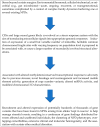A Unifying Hypothesis for the Genome Dynamics Proposed to Underlie Neuropsychiatric Phenotypes
- PMID: 38674405
- PMCID: PMC11049865
- DOI: 10.3390/genes15040471
A Unifying Hypothesis for the Genome Dynamics Proposed to Underlie Neuropsychiatric Phenotypes
Abstract
The sheer number of gene variants and the extent of the observed clinical and molecular heterogeneity recorded in neuropsychiatric disorders (NPDs) could be due to the magnified downstream effects initiated by a smaller group of genomic higher-order alterations in response to endogenous or environmental stress. Chromosomal common fragile sites (CFS) are functionally linked with microRNAs, gene copy number variants (CNVs), sub-microscopic deletions and duplications of DNA, rare single-nucleotide variants (SNVs/SNPs), and small insertions/deletions (indels), as well as chromosomal translocations, gene duplications, altered methylation, microRNA and L1 transposon activity, and 3-D chromosomal topology characteristics. These genomic structural features have been linked with various NPDs in mostly isolated reports and have usually only been viewed as areas harboring potential candidate genes of interest. The suggestion to use a higher level entry point (the 'fragilome' and associated features) activated by a central mechanism ('stress') for studying NPD genetics has the potential to unify the existing vast number of different observations in this field. This approach may explain the continuum of gene findings distributed between affected and unaffected individuals, the clustering of NPD phenotypes and overlapping comorbidities, the extensive clinical and molecular heterogeneity, and the association with certain other medical disorders.
Keywords: GWAS; RAG 1/2; common fragile sites; epigenetic; genome plasticity; immune; mobile elements; neuropsychiatric; stress.
Conflict of interest statement
The author declares no conflict of interest.
Figures
References
-
- iPSYCH. [(accessed on 10 February 2024)]. Available online: http://ipsych.au.dk.
-
- Psychiatric Genomics Consortium (PGC) [(accessed on 10 February 2024)]. Available online: http://www.med.unc.edu/pgc.
Publication types
MeSH terms
LinkOut - more resources
Full Text Sources
Medical


